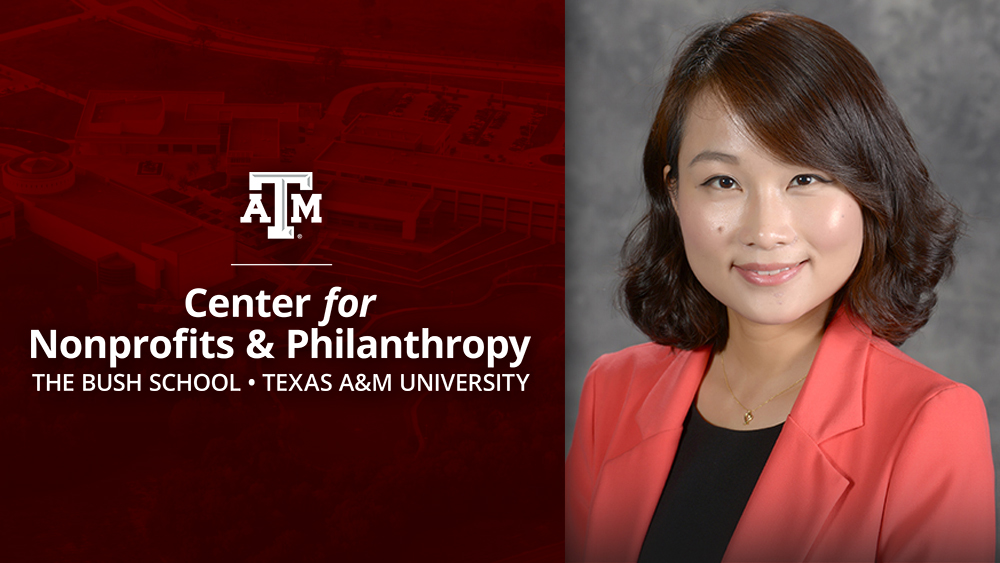
Is overhead a tainted word?
For Bush School of Government and Public Service Assistant Professor Dr. Ellie Heng Qu, the answer is yes.
Qu lectures in the Department of Public Service and Administration and studies nonprofit management and philanthropy. Her research covers a range of topics that have practical implications for capacity building and resource development of nonprofit organizations.
“I look at individual prosocial behavior, such as volunteering, and charitable giving. I look at, for example, under what circumstances people are becoming more prosocial,” said Qu. “I also study strategies to help nonprofit organizations generate and manage their resources.”
One of Qu’s recent publications explores ways nonprofit organizations can reduce negative perceptions of the organization by donors who react negatively to the word overhead. Overhead includes all administrative expenses borne by the organization, such as non-programmatic employee compensation and facilities.
“When people donate to a charitable organization, they usually don’t like for it to spend too much on non-programmatic expenses,” said Qu. This leads to what nonprofit scholars term overhead aversion, or a tendency among donors to restrain their giving toward organizations with perceived high levels of non-program expenditure. Yet overhead funds critical infrastructure that enables nonprofit organizations to continue functioning and have a social impact.
“Organizations are run by people. Unfortunately, people are titled overhead. By being able to cope with the misconception, we can help nonprofit organizations mitigate the negative influence of overhead aversion and, consequently, the underinvestment in overhead and nonprofit infrastructure.”
Dr. Ellie Heng Qu
“It’s a vicious cycle in that organizations know donors are averse to overhead, so they underspend on overhead,” said Qu. “But nonprofit overhead is not necessarily a bad thing, right? For example, we want to attract quality employees to work in the nonprofit sector. When you want to hire quality people, you do need to spend more.”
Overhead aversion doesn’t just harm individual organizations. Sustained overhead aversion restricts organizational growth and can be destructive to the nonprofit sector as a whole.
“Organizations are facing this pressure to underinvest in their infrastructure, which would hurt their long-term, sustainable development,” said Qu. “When organizations don’t grow or when they size down, they cannot have as much social impact.”
To address this issue, Qu partnered with Jamie Levine Daniel of the Paul H. O’Neill School of Public and Environmental Affairs at Indiana University–Purdue University Indianapolis to examine what techniques might influence donors’ perceptions of overhead.
Performing a survey experiment on donors who have given to charitable organizations in the past five years, Qu and Daniel evaluated two treatments for reducing overhead aversion: framing and omission of the word overhead.
Study participants indicated less willingness to donate to organizations with higher percentages of overhead expenditure. In the first treatment, Qu and Daniel show that nonprofits can improve their communication strategies by framing overhead in terms of its necessity and application. When provided an explanation on how overhead contributes to long-term organizational capacity, respondents were more likely to support organizations with higher overhead costs. Qu and Daniel saw a 14 percent decrease in donors indicating overhead aversion.
In the other treatment, Qu and Daniel assessed donors’ willingness to give when the word overhead was not explicitly used in fundraising material. The percentage of respondents indicating overhead aversion further decreased by 7 percent.
“We saw that this simple technique actually increased people’s willingness to donate to organizations with comparatively high overhead compared to not providing any explanations about overhead,” said Qu.
“Dr. Qu does important work to understand why and when people give. This is of interest because understanding the psychological and social motivations of donors and volunteers could encourage more prosocial behavior, which is the foundation of a healthy society.”
Dr. William A. Brown, Director of the Center for Nonprofits and Philanthropy at the Bush School
When asked to give an example of overhead, nearly half of respondents could not think of one. Still others confused overhead with program-related expenses.
“That speaks to people’s misconception about overhead. They may not know what it means but decide to refute overhead spending anyway. This says that nonprofit organizations need to communicate better in their fundraising materials with donors.”
“It was surprising to us because we didn’t expect a large effect size. That was surprising in a good way because it means explanations work. It’s a simple, effective, and low-cost strategy to reduce overhead aversion.”
The framing strategy did not completely overcome overhead aversion. Nevertheless, it did serve to mitigate the influence of negative preconceptions donors may have about overhead.
Qu said the word overhead sometimes obscures its true purpose. “Organizations are run by people,” she said. “Unfortunately, people are titled overhead. By being able to cope with the misconception, we can help nonprofit organizations mitigate the negative influence of overhead aversion and, consequently, the underinvestment in overhead and nonprofit infrastructure.”
Qu and Daniel have presented their research at numerous conferences, where it has garnered significant scholar and practitioner interest. They also discussed their findings on Fresh Research, a podcast by the NonProfit Times.
“It is a good sign when research is relevant to the practice,” said Qu.
Dr. William A. Brown, Director of the Center for Nonprofits and Philanthropy at the Bush School, elaborated on the significance of Qu’s research. “Dr. Qu does important work to understand why and when people give. This is of interest because understanding the psychological and social motivations of donors and volunteers could encourage more prosocial behavior, which is the foundation of a healthy society.”
More information about research at the Center for Nonprofits and Philanthropy can be found online at bush.tamu.edu/nonprofit.
By Micaela Burrow
